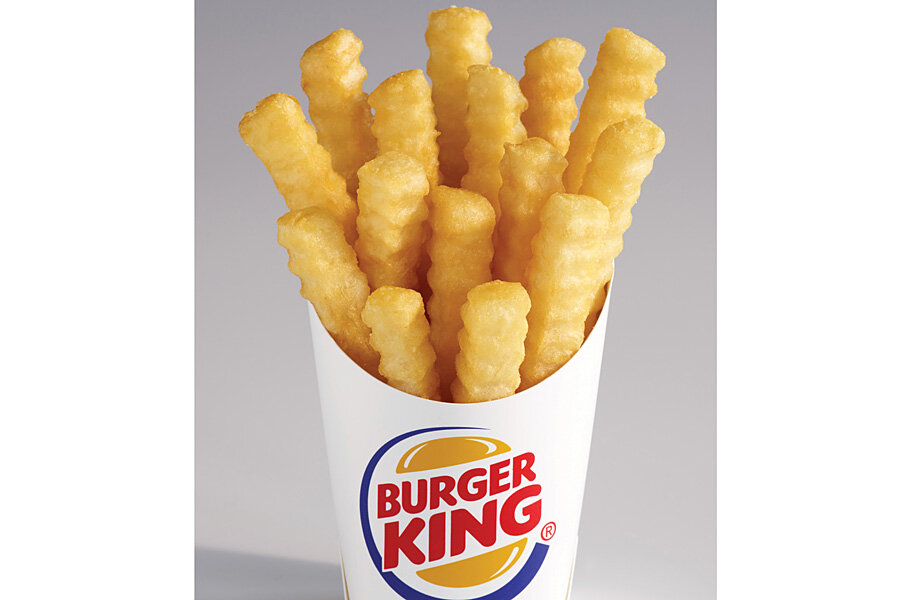Burger King flop: Chain axes low-calorie 'Satisfries' after one year
Loading...
| New York
Burger King is getting rid of its lower-calorie french fries at most restaurants after less than a year.
The Miami-based chain said in a statement that it gave its franchisees the option to continue selling the french fries earlier this week. Only about 2,500 of the approximately 7,400 locations in the U.S. and Canada opted to continue selling them as a permanent item. The others have started phasing them out.
The french fries, called "Satisfries," were a big bet for Burger King when they were announced in September. But they weren't as well received as Burger King had hoped. The Monitor outlined the obstacles facing the concept of a healthier fry when 'Satisfries' were announced last September:
Can French fries be nutritious? It’s a tall order, especially for a side item that is primarily a delivery mechanism for carbohydrates, oil, and salt. But while “healthy” fries are probably outside the realm of possibility, maybe just “slightly less junky” ones aren’t. Enter Burger King and “Satisfries.”
The Miami-based hamburger chain announced Tuesday the addition of a lower-calorie, lower-fat fry option to its menus. Satisfries, according to Burger King, will have 30 percent less fat and 20 percent fewer calories than the company’s regular fries (which will remain on the menu, untouched). As with most Burger King product announcements, this one also doubles as a jab at its more successful competitor – the new fries have 40 percent less fat and 30 percent fewer calories than industry leader McDonald’s fries, according to Burger King.
The only thing going up is the price – Satisfries, which come in a crinkle-cut shape, will cost 20 to 30 cents more than their high-calorie counterparts (but the cost will be the same in kids meals, where the new fries are also an option).
The launch comes as fast food menus work to incorporate healthier options into their menus at the behest of customers and consumer health advocates. But until now, that effort has mostly involved adding more conspicuously nutritious items like salads, smoothies, and yogurt parfaits alongside the usual burger and fries fare.
The Burger King announcement is different because it incorporates some measure of nutrition-consciousness into that burger-and-fries backbone of the fast food world. According to the company, the new fries are essentially the same as the regular ones, but for a slightly tweaked recipe that helps the batter of the fries block more oil absorption.
"It's not realistic to ask people to replace French fries with carrots or celery sticks," says Keri Gans, a registered dietitian hired by Burger King, told USA Today. "This is like meeting people halfway."
Since being taken over by ownership group 3G Capital in 2010, Burger King has made a number of health-minded changes to its menu, including the introduction of new salads and smoothies, as well as minor adjustments, like taking one of two slices of cheese off its burgers.
Satisfries, however, have the potential for the biggest impact. Burger King serves approximately 100 million customers per month, and 56 million of those – over 1 in 2 – order French fries. “We know our guests are hungry for options that are better for them, but don't want to compromise on taste," said Alex Macedo, president of Burger King in North America, in the company press release. "When it comes to what we eat, we know that small changes can have a big impact.”
Will they succeed? It’s too early to say, but this sort of product – a lighter version of a fast food staple – already has a bit of a track record, and it isn’t promising. In 1991, amid much fanfare, McDonald’s introduced the McLean Deluxe, which had 10 grams of fat compared to the Big Mac’s 26. The problem? McDonald’s achieved such a low fat content by forming the beef patties with seaweed and water, and the finished product just didn’t taste as good as the other hamburgers on the menu. It was discontinued by 1996.
The name was mocked in some corners, with one website referring to them as "Saddest Fries." There also is some confusion about their caloric superiority, with a small order still containing 270 calories. A small order of McDonald's fries, by comparison, has 230 calories because the serving weighs less.
Satisfries also are pricier, costing about $1.89 for a small order, compared with a $1.59 for regular fries.
And it's unclear whether customers were aware what made the fries lower in calories. Burger King said Satisfries used a different type of batter to prevent some oil from being absorbed by the potatoes during frying. But the company did not have signs in restaurants explaining the difference between Satisfries and regular fries.
It's just one of the gambits by Burger King since investment firm 3G Capital took it public again 2012. Other moves have included the return of the "Big King," which resembles a Big Mac and a "French Fry Burger," which is essentially a burger with four french fries smashed on top.
The efforts haven't yet sparked any big sales gains at a time when traditional fast-food chains are struggling. In the latest quarter, sales at established restaurants in the U.S. and Canada edged up just 0.4 percent.
This week, Burger King Worldwide Inc. also announced the return of "Chicken Fries" for a limited time. The company said it brought back the deep-fried chicken in response to demand it saw online.







